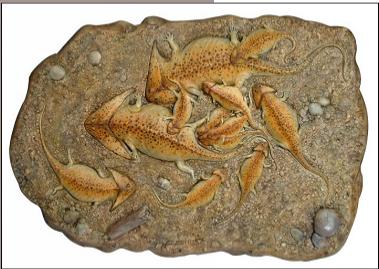Diplocaulus (meaning "double stalk") was not a dinosaur but an early amphibian, now extinct. It was distinguished by its boomerang-shaped head which was formed by two elongated bones at the back of the head. It had four short legs, and a short, flattened tail. It was about 3 feet (1 m) long.
Its unusually-shaped head may have made it difficult for predators, such as Eryops, to swallow it. Its head also may have been used as a hydrofoil, letting Diplocaulus swim against the current. It may have used its tail to help it swim.
Diet
Diplocaulus probably ate insects and fish.
Habitat
Like all amphibians, it had to live near the water since amphibian eggs have no shells and must be laid in the water (or in very damp areas) or they will dry out and die. Also, it lost its gills as an adult.
When Diplocaulus Lived
Diplocaulus lived from the late Carboniferous to the late Permian period (roughly 270 million years ago), long before the dinosaurs evolved.
Classification
Diplocaulus was a tetrapod, an amphibian, a labyrinthodont, a lepospondyl, and a nectridian.
Fossils
Diplocaulus fossils have been found in Texas, USA, North America.
Its unusually-shaped head may have made it difficult for predators, such as Eryops, to swallow it. Its head also may have been used as a hydrofoil, letting Diplocaulus swim against the current. It may have used its tail to help it swim.
Diet
Diplocaulus probably ate insects and fish.
Habitat
Like all amphibians, it had to live near the water since amphibian eggs have no shells and must be laid in the water (or in very damp areas) or they will dry out and die. Also, it lost its gills as an adult.
When Diplocaulus Lived
Diplocaulus lived from the late Carboniferous to the late Permian period (roughly 270 million years ago), long before the dinosaurs evolved.
Classification
Diplocaulus was a tetrapod, an amphibian, a labyrinthodont, a lepospondyl, and a nectridian.
Fossils
Diplocaulus fossils have been found in Texas, USA, North America.

[[Home]
[News] [Life-Size Sculptures] [Model Kits] [Wildlife Collection]
[Complete Catalog]
[About Us] [Contact Us]
[Frequent Questions] [The Studio At Work] [Links] [Privacy Policy] [Terms of Use]
mail@cmstudio.com
© 2017 CM Studio
All Rights Reserved
CM Studio 100 West Central Avenue Benld, Illinois 62009
[News] [Life-Size Sculptures] [Model Kits] [Wildlife Collection]
[Complete Catalog]
[About Us] [Contact Us]
[Frequent Questions] [The Studio At Work] [Links] [Privacy Policy] [Terms of Use]
mail@cmstudio.com
© 2017 CM Studio
All Rights Reserved
CM Studio 100 West Central Avenue Benld, Illinois 62009

